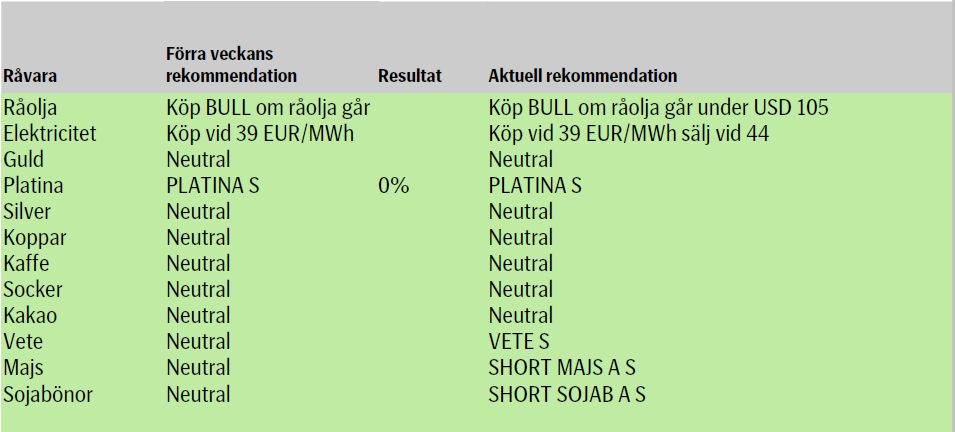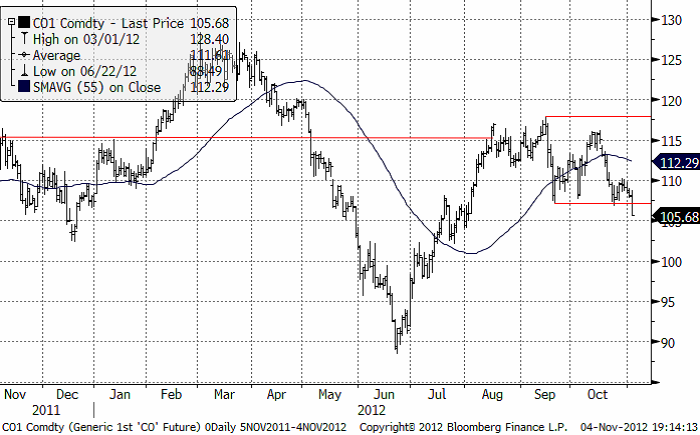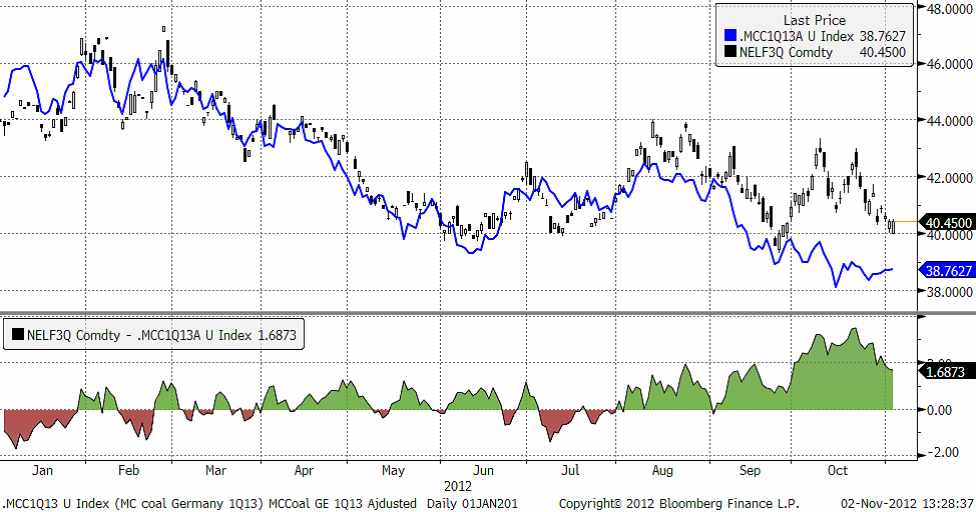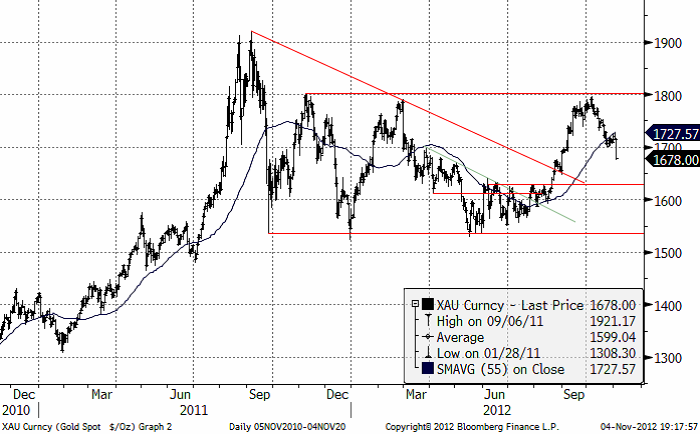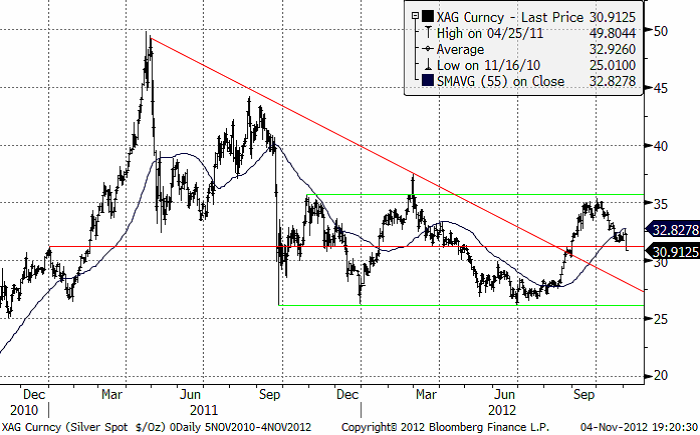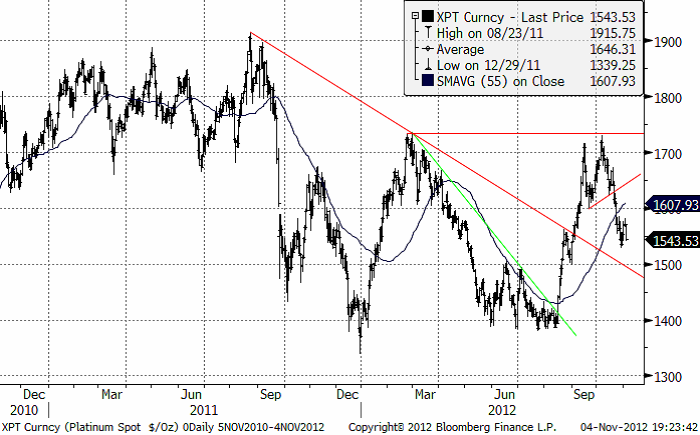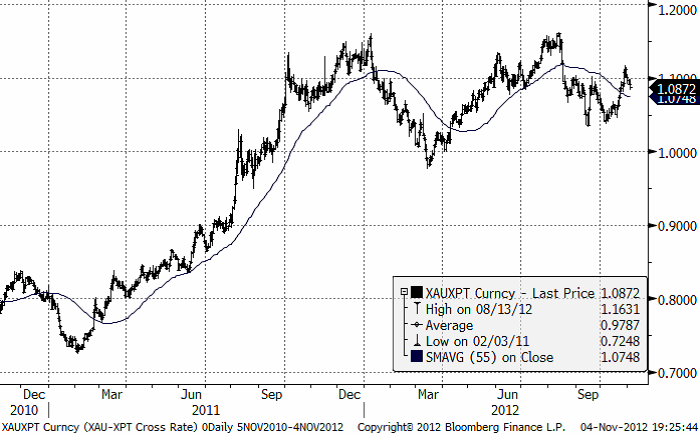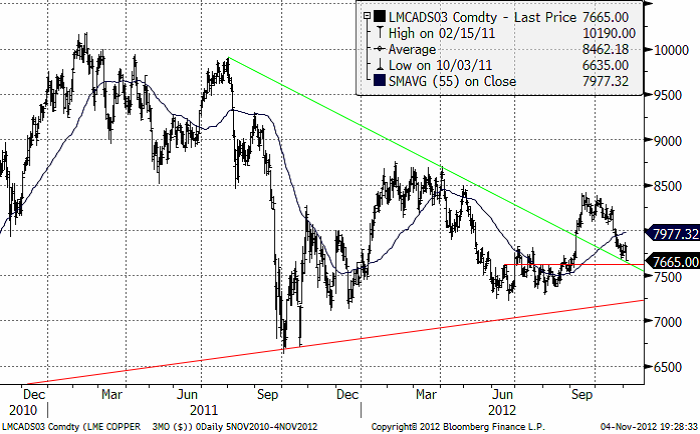Analys
SEB – Råvarukommentarer, 5 november 2012
Sammanfattning av rekommendationer
Råolja – Brent
Vi fortsätter rekommendera köp av Bull Olja och Olja S vid nedgång på Brent kring $105/fat. Vi bedömer det som osannolikt att priset på råolja kommer att rasa lägre än så, såvida inte tillväxtprognoserna skrivs ned väsentligt. Vår uppfattning är att oljepriset kommer att fortsätta vara väl understött med tanke på stora geopolitiska risker, strama marknader för oljeprodukter, höga incitamentpriser för att stimulera till tillräckliga investeringar i ny kapacitet och behovet av att producentländer försvarar priser för att balansera budgetar.
Medan balansen på råoljemarknaden förbättrats något är situationen för mellandestillat fortsatt mer ansträngd. Lagren av mellandestillat är historiskt låga och en kallare än normal vinter kan komma försvåra situation ytterligare. Även under normala omständigheter har raffinaderierna problem att producera tillräckligt med mellandestillat under uppvärmningssäsongen. Det gör förråden till en nyckelfaktor för balanseringen av marknaden. Den långsiktiga strukturella balansen för marknaden för mellandestillat är också oroande eftersom det är där vi ser den enda konsumtionstillväxten i Europa.
Det som dominerat nyhetsflödet i veckan är stormen Sandy, vars framfart lett till stor förödelse, både mänskligt och materiellt. Kostnaden för Sandy beräknas nu vara uppe i 50 mdr dollar. Två tredjedelar av raffinaderierna på den amerikanska östkusten, den största oljeledningen, de flesta större hamnar samt vägar och flygplatser stängdes som en följd av Sandy. Efterfrågan minskade därmed på råolja, vilket pressat priset något. Rörelserna har ändå varit begränsade och råoljepriset ganska stabilt mellan 108 och 110 usd. För oljeprodukter, inte minst bensin, har Sandy istället lett till stora uppgångar, eftersom utbudet minskat då raffinaderikapaciteten minskat och människor hamstrat drivmedel.
Iran som är starkt pressat av sanktionerna mot landet har hittills inte gett efter för trycket från omvärlden men Irans försvarsminister uppges nu ha sagt att man inte har några planer på att stänga den vitala farleden genom Hormuzsundet då ”dessa två frågor (stängning av Hormuzsundet och sanktioner mot landet) är helt oberoende och inte relaterade till varandra”.
Vår rekommendation förblir att köpa BULL OLJA X4 S eller OLJA S om priset faller ned mot 105 dollar. På den nivån ser vi goda möjligheter att tjäna pengar.
Elektricitet
Förra veckan sänkte vi vår ingångsnivå för longa positioner till €39/MWh för Q1-2013-kontraktet på Nord Pool. Motivet var att marginalkostnaden för kolkraftproduktion fortsatt falla. Vi rekommenderar att handla kontraktet från köpsidan under november om denna utgångsnivå uppnås. Å andra sidan är €43/MWh till €44/MWh bra utgångspunkter för de som tar risken att handla vinterkontraktet NELFQ3 från säljsidan med BEAR EL X2 S eller med BEAR EL X4 S.
Situationen sedan förra veckan är i stort oförändrad. Det totala hydrologiska överskottet är 10-13 TWh över normalt samtidigt som kärnkraften har god tillgänglighet. Vi har därför länge argumenterat för att differensen mellan NELF3Q och vårt MCCP-index (.MCC1Q13) varit alltför stor. Nu har så en korrigering skett och differensen minskat en del. Q1-2013-kontraktet (NELF3Q) har, i takt med lägre marginalkostnad för kolkraft och fortsatt nederbördsrikt väder, pressats lägre och är senast omsatt på €40,50/MWh. Kontraktet har ändå lite ytterligare fallhöjd och ska, i rådande miljö, närma sig €39/MWh nivån innan vi tycker att kontraktet är köpvärt.
Ska man sammanfatta elmarknaden, så är det att det stora prisfallet tycks vara över. Marknaden handlar ”sidledes” med 44 euro som övre gräns. Nu har vi sänkt den nedre gränsen till 39 euro från 40 euro. I den här typen av marknaden kan man försöka komma in med BULL EL X2 S nära 39 och försöka sälja nära 44 euro. Vice versa att då försöka köpa BEAR EL X4 S.
Guld och Silver
Ädelmetallerna har det jobbigt i nuvarande miljö. Som noterats de senaste två veckorna är statistiken ”för stark”. Fredagens arbetssiffra med påföljande dollarstyrka satte ordentlig press. Spotguld i London föll kraftigt från $1714 ned till $1678. Den mer volatila systermetallen silver föll procentuellt ungefär dubbelt så mycket. Vi håller oss neutrala på ädelmetaller, men det kan vara värt att börja leta köplägen. Tekniskt sett kan det fortsätta ner de närmsta dagarna, med nästa stora stödnivå för guld kring $1650.
Nedan ser vi kursdiagrammet för guld. Notera stödlinjen på 1630 dollar per uns. Om 1650 inte håller, finns nästa stöd på den nivån.
Nedan ser vi kursdiagrammet för silver i dollar per troy ounce. Vi ser att 35 dollar är ett viktigt motstånd och att 30 dollar är ett viktigt stöd. Vi skrev förra veckan att en fortsatt nedgång till 30 dollar skulle vara ett bra köptillfälle. En stopp-loss-order bör då placeras strax under 30 dollar. Detta gäller fortfarande.
Platina
Platina föll ungefär som guldet, dock något mindre strax under 2 %. Situationen i Sydafrika är lugnare, men problemen kvarstår och gruvorna har svårt med lönsamheten. Det allmänna stämningsläget kring både bas- och ädelmetaller är dock inte det bästa just nu. Vi rekommenderar att man försöker komma in på den långa sidan i platina. Risken är dock påtaglig att priset faller ner till 1500 dollar per uns. Det tror vi i så fall är ett bra pris att köpa på.
Nedan ser vi priset på guld dividerat med priset på platina. Platina har utvecklats bättre än guld. Det är en tendens vi ”borde” se mer av med tanke på att priset på guld stigit så mycket över den historiska relationen till platina och att platinagruvorna har problem med lönsamheten. Vi anser att detta är ett bra argument för att sälja guld och köpa platina, allt annat lika, eller att köpa platina enbart.
Koppar
Det är lite motsägelsefullt just nu. Fokus ligger på USA där det fortsätter att komma in positiv konjunkturdata, något som naturligtvis borde vara positivt för metallerna. Efterfrågan ökar igen. Problemet är bara att de som investerat i råvaror på basis av fortsatta penningpolitiska åtgärder från centralbanken, blir besvikna (sannolikheten minskar för ytterligare stimulanser i takt med att ekonomin återhämtar sig). Positioner som togs i september likvideras. Förra fredagen redovisades amerikansk BNP-tillväxt starkare än väntat för kvartal 3 på 2 %, jämfört med 1,3 % kvartalet före. Oro för stormen under veckans inledning lade sordin på stämningen och vi fick se ett prisfall på mellan 2 och 3 %. Kina stimulerar via marknadsoperationer vilket fick den korta inhemska räntan att falla kraftigt. Metallpriserna återhämtade i princip hela veckans fall och stod i torsdags oförändrade. På fredagen kom nästa ”kalldusch” med starka siffror. Arbetsmarknadsstatistik kom in mycket bättre än väntat, och på samma tema, d.v.s. minskad sannolikhet för ytterligare stimulanser från FED, så rasade priserna igen. Tendensen varierar mellan basmetallerna. Koppar och nickel tog mest stryk, medan zinken går mot strömmen och är faktiskt upp ett par procent i veckan. Aluminium stänger oförändrad.
Koppar
Efter fredagens statistik tappade kopparn 2 % vilket också blir veckans facit. De starkare amerikanska siffrorna stärker dollarn, vilket traditionellt är negativt för dollarnoterade råvaror. Effekten är särskilt tydlig för ädelmetaller, men koppar har svårt att stå emot när dollarrörelsen blir kraftig (EURUSD föll från 1,2930 till 1,2835 under fredagseftermiddagen). LME-lagret har ökat med nästan 10 % de två senaste veckorna. Det ska inte ses som alltför negativt, då det främst är en effekt av terminskurvan, som en tid har varit i s.k. backwardation (terminspriserna är lägre an spot). Detta ”lockar fram” fysisk vara som inte är ämnad för omedelbar konsumtion. Vad som oroar är börslagret i Shanghai, som också ökade under veckan med 1,5 %. Inte så mycket, men det tyder på att Kinas konsumtion inte riktigt vill komma igång. I nuvarande marknadssituation kan det vara värt att avvakta och hålla sig neutral, men vi kvarstår med bedömningen att koppar har en i grunden stark fundamenta med relativt små globala lagernivåer. Minsta tendens till stimulanspaket från Kina så vänder trenden väldigt snabbt. Den tekniska analysen indikerar fortsatt prispress nästa vecka. Vi har $7600 för LME-koppar i sikte som en första ”jämna” stödnivå. Om den nivån bryter får vi inte räkna bort möjligheten för en tillfällig botten ned till $7400.
Som man ser i diagrammet ovan, har mycket handel tidigare skett i ett område kring 7500 dollar. I det området låg handeln mellan maj och början på september. Före det var det ett bottenområde även för perioden september till december. Vi gissar att samma köpintressen som fanns då, nog kommer att finnas kvar även nu i november. Kommer priset ner till 7500 ska man nog anse det vara ett bra köptillfälle. Det man köper då är t ex KOPPAR S.
För spannmål och övriga jordbruksprodukter hänvisas till senaste utgåvan av veckobrevet om jordbruksprodukter.
[box]SEB Veckobrev Veckans råvarukommentar är producerat av SEB Merchant Banking och publiceras i samarbete och med tillstånd på Råvarumarknaden.se[/box]
Disclaimer
The information in this document has been compiled by SEB Merchant Banking, a division within Skandinaviska Enskilda Banken AB (publ) (“SEB”).
Opinions contained in this report represent the bank’s present opinion only and are subject to change without notice. All information contained in this report has been compiled in good faith from sources believed to be reliable. However, no representation or warranty, expressed or implied, is made with respect to the completeness or accuracy of its contents and the information is not to be relied upon as authoritative. Anyone considering taking actions based upon the content of this document is urged to base his or her investment decisions upon such investigations as he or she deems necessary. This document is being provided as information only, and no specific actions are being solicited as a result of it; to the extent permitted by law, no liability whatsoever is accepted for any direct or consequential loss arising from use of this document or its contents.
About SEB
SEB is a public company incorporated in Stockholm, Sweden, with limited liability. It is a participant at major Nordic and other European Regulated Markets and Multilateral Trading Facilities (as well as some non-European equivalent markets) for trading in financial instruments, such as markets operated by NASDAQ OMX, NYSE Euronext, London Stock Exchange, Deutsche Börse, Swiss Exchanges, Turquoise and Chi-X. SEB is authorized and regulated by Finansinspektionen in Sweden; it is authorized and subject to limited regulation by the Financial Services Authority for the conduct of designated investment business in the UK, and is subject to the provisions of relevant regulators in all other jurisdictions where SEB conducts operations. SEB Merchant Banking. All rights reserved.
Analys
Tightening fundamentals – bullish inventories from DOE

The latest weekly report from the US DOE showed a substantial drawdown across key petroleum categories, adding more upside potential to the fundamental picture.

Commercial crude inventories (excl. SPR) fell by 5.8 million barrels, bringing total inventories down to 415.1 million barrels. Now sitting 11% below the five-year seasonal norm and placed in the lowest 2015-2022 range (see picture below).
Product inventories also tightened further last week. Gasoline inventories declined by 2.1 million barrels, with reductions seen in both finished gasoline and blending components. Current gasoline levels are about 3% below the five-year average for this time of year.
Among products, the most notable move came in diesel, where inventories dropped by almost 4.1 million barrels, deepening the deficit to around 20% below seasonal norms – continuing to underscore the persistent supply tightness in diesel markets.
The only area of inventory growth was in propane/propylene, which posted a significant 5.1-million-barrel build and now stands 9% above the five-year average.
Total commercial petroleum inventories (crude plus refined products) declined by 4.2 million barrels on the week, reinforcing the overall tightening of US crude and products.


Analys
Bombs to ”ceasefire” in hours – Brent below $70

A classic case of “buy the rumor, sell the news” played out in oil markets, as Brent crude has dropped sharply – down nearly USD 10 per barrel since yesterday evening – following Iran’s retaliatory strike on a U.S. air base in Qatar. The immediate reaction was: “That was it?” The strike followed a carefully calibrated, non-escalatory playbook, avoiding direct threats to energy infrastructure or disruption of shipping through the Strait of Hormuz – thus calming worst-case fears.

After Monday morning’s sharp spike to USD 81.4 per barrel, triggered by the U.S. bombing of Iranian nuclear facilities, oil prices drifted sideways in anticipation of a potential Iranian response. That response came with advance warning and caused limited physical damage. Early this morning, both the U.S. President and Iranian state media announced a ceasefire, effectively placing a lid on the immediate conflict risk – at least for now.
As a result, Brent crude has now fallen by a total of USD 12 from Monday’s peak, currently trading around USD 69 per barrel.
Looking beyond geopolitics, the market will now shift its focus to the upcoming OPEC+ meeting in early July. Saudi Arabia’s decision to increase output earlier this year – despite falling prices – has drawn renewed attention considering recent developments. Some suggest this was a response to U.S. pressure to offset potential Iranian supply losses.
However, consensus is that the move was driven more by internal OPEC+ dynamics. After years of curbing production to support prices, Riyadh had grown frustrated with quota-busting by several members (notably Kazakhstan). With Saudi Arabia cutting up to 2 million barrels per day – roughly 2% of global supply – returns were diminishing, and the risk of losing market share was rising. The production increase is widely seen as an effort to reassert leadership and restore discipline within the group.
That said, the FT recently stated that, the Saudis remain wary of past missteps. In 2018, Riyadh ramped up output at Trump’s request ahead of Iran sanctions, only to see prices collapse when the U.S. granted broad waivers – triggering oversupply. Officials have reportedly made it clear they don’t intend to repeat that mistake.
The recent visit by President Trump to Saudi Arabia, which included agreements on AI, defense, and nuclear cooperation, suggests a broader strategic alignment. This has fueled speculation about a quiet “pump-for-politics” deal behind recent production moves.
Looking ahead, oil prices have now retraced the entire rally sparked by the June 13 Israel–Iran escalation. This retreat provides more political and policy space for both the U.S. and Saudi Arabia. Specifically, it makes it easier for Riyadh to scale back its three recent production hikes of 411,000 barrels each, potentially returning to more moderate increases of 137,000 barrels for August and September.
In short: with no major loss of Iranian supply to the market, OPEC+ – led by Saudi Arabia – no longer needs to compensate for a disruption that hasn’t materialized, especially not to please the U.S. at the cost of its own market strategy. As the Saudis themselves have signaled, they are unlikely to repeat previous mistakes.
Conclusion: With Brent now in the high USD 60s, buying oil looks fundamentally justified. The geopolitical premium has deflated, but tensions between Israel and Iran remain unresolved – and the risk of missteps and renewed escalation still lingers. In fact, even this morning, reports have emerged of renewed missile fire despite the declared “truce.” The path forward may be calmer – but it is far from stable.
Analys
A muted price reaction. Market looks relaxed, but it is still on edge waiting for what Iran will do

Brent crossed the 80-line this morning but quickly fell back assigning limited probability for Iran choosing to close the Strait of Hormuz. Brent traded in a range of USD 70.56 – 79.04/b last week as the market fluctuated between ”Iran wants a deal” and ”US is about to attack Iran”. At the end of the week though, Donald Trump managed to convince markets (and probably also Iran) that he would make a decision within two weeks. I.e. no imminent attack. Previously when when he has talked about ”making a decision within two weeks” he has often ended up doing nothing in the end. The oil market relaxed as a result and the week ended at USD 77.01/b which is just USD 6/b above the year to date average of USD 71/b.

Brent jumped to USD 81.4/b this morning, the highest since mid-January, but then quickly fell back to a current price of USD 78.2/b which is only up 1.5% versus the close on Friday. As such the market is pricing a fairly low probability that Iran will actually close the Strait of Hormuz. Probably because it will hurt Iranian oil exports as well as the global oil market.
It was however all smoke and mirrors. Deception. The US attacked Iran on Saturday. The attack involved 125 warplanes, submarines and surface warships and 14 bunker buster bombs were dropped on Iranian nuclear sites including Fordow, Natanz and Isfahan. In response the Iranian Parliament voted in support of closing the Strait of Hormuz where some 17 mb of crude and products is transported to the global market every day plus significant volumes of LNG. This is however merely an advise to the Supreme leader Ayatollah Ali Khamenei and the Supreme National Security Council which sits with the final and actual decision.
No supply of oil is lost yet. It is about the risk of Iran closing the Strait of Hormuz or not. So far not a single drop of oil supply has been lost to the global market. The price at the moment is all about the assessed risk of loss of supply. Will Iran choose to choke of the Strait of Hormuz or not? That is the big question. It would be painful for US consumers, for Donald Trump’s voter base, for the global economy but also for Iran and its population which relies on oil exports and income from selling oil out of that Strait as well. As such it is not a no-brainer choice for Iran to close the Strait for oil exports. And looking at the il price this morning it is clear that the oil market doesn’t assign a very high probability of it happening. It is however probably well within the capability of Iran to close the Strait off with rockets, mines, air-drones and possibly sea-drones. Just look at how Ukraine has been able to control and damage the Russian Black Sea fleet.
What to do about the highly enriched uranium which has gone missing? While the US and Israel can celebrate their destruction of Iranian nuclear facilities they are also scratching their heads over what to do with the lost Iranian nuclear material. Iran had 408 kg of highly enriched uranium (IAEA). Almost weapons grade. Enough for some 10 nuclear warheads. It seems to have been transported out of Fordow before the attack this weekend.
The market is still on edge. USD 80-something/b seems sensible while we wait. The oil market reaction to this weekend’s events is very muted so far. The market is still on edge awaiting what Iran will do. Because Iran will do something. But what and when? An oil price of 80-something seems like a sensible level until something do happen.
-

 Nyheter3 veckor sedan
Nyheter3 veckor sedanStor uppsida i Lappland Guldprospekterings aktie enligt analys
-

 Nyheter4 veckor sedan
Nyheter4 veckor sedanBrookfield ska bygga ett AI-datacenter på hela 750 MW i Strängnäs
-

 Nyheter4 veckor sedan
Nyheter4 veckor sedanSommaren inleds med sol och varierande elpriser
-

 Nyheter3 veckor sedan
Nyheter3 veckor sedanSilverpriset släpar efter guldets utveckling, har mer uppsida
-

 Nyheter4 veckor sedan
Nyheter4 veckor sedanTradingfirman XTX Markets bygger datacenter i finska Kajana för 1 miljard euro
-

 Nyheter2 veckor sedan
Nyheter2 veckor sedanUppgången i oljepriset planade ut under helgen
-

 Nyheter2 veckor sedan
Nyheter2 veckor sedanLåga elpriser i sommar – men mellersta Sverige får en ökning
-

 Analys2 veckor sedan
Analys2 veckor sedanVery relaxed at USD 75/b. Risk barometer will likely fluctuate to higher levels with Brent into the 80ies or higher coming 2-3 weeks


